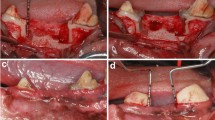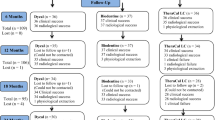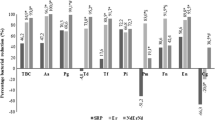Abstract
The aim of this study was the evaluation of the effectiveness of photodynamic therapy on the decontamination of artificially induced carious bovine dentin, using Photogem® as the photosensitizer agent and an LED device as a light source. Dentin samples obtained from bovine incisors were immersed in sterile broth supplemented by Lactobacillus acidophillus 108 colony formation units (CFU) and Streptococcus mutans 108 CFU. Different concentrations of photosensitizer, PA = 1 mg/ml, PB = 2 mg/ml, and PC = 3 mg/ml, and two fluences, D = 24 J/cm2 and D = 48 J/cm2, were investigated. After CFU counting per milligram of carious dentin and statistical analysis, we observed that the photodynamic therapy (PDT) parameters used were effective for bacterial reduction in the in vitro model under study. The best result was achieved with the application of Photogem® at 2 mg/ml and photoactivated under 24 J/cm2 showing a survival factor of 0.14. At higher photosensitizer concentrations, a higher dark toxicity was observed. We propose a simple mathematical expression for the determination of PDT parameters of photosensitizer concentration and light fluence for different survival factor values. Since LED devices are simpler and cheaper compared to laser systems, it would be interesting to verify their efficacy as a light source in photodynamic therapy for the decontamination of carious dentin.
Similar content being viewed by others
References
T. J. Dougherty, G. B. Grindy, R. Field, et al., J. Natl. Cancer Inst. 55, 115 (1975).
S. G. Granelli, I. Diamopnd, A. F. McDonagh, et al., Cancer Res. 35, 2567 (1975).
T. Burns, M. Wilson, and G. J. Pearson, J. Med. Microbiol. 38, 401 (1993).
J. Dobson and M. Wilson, Arch. Oral Biol. 37, 883 (1992).
H. Okamoto, T. Iwase, and T. Marioka, Lasers Surg. Med. 12, 450 (1992).
M. Wilson, J. Dobson, and S. Sarkar, Oral Microbiol. Immunol. 8, 182 (1993).
M. Wilson, J. Appl. Bacteriol. 75, 299 (1993).
M. Wilson, Int. Dent. J. 44, 181 (1994).
M. Wilson, T. Burns, J. Pratten, and G. J. Pearson, J. Appl. Bacteriol., 78, 569 (1995).
L. Bjorndal, T. Larsen, and A. Thylstrup, Caries Res. 31, 411 (1997).
E. A. M. Kidd, S. Joyston-Bechal, and D. Beighton, Caries Res. 27, 402 (1993).
E. A. M. Kidd, D. N. J. Ricketts, and D. Beighton, Br. Dent. J. 180, 287 (1996).
A. J. P. van Trijp, T. J. M. van Streenbergen, and J. M. Ten Cate, Caries Res. 28, 21 (1994).
J. A. Williams, G. J. Pearson, M. J. Colles, and M. Wilson, Caries Res. 37, 190 (2003).
T. Burns, M. Wilson, and G. J. Pearson, Caries Res. 29, 192 (1995).
J. A. Williams, G. J. Pearson, M. J. Colles, and M. Wilson, Caries Res. 38, 530 (2004).
I. C. Zanin, R. B. Gonçalves, A. B. Vjunior, et al., J. Antimicrob Chemother. 56, 324 (2005).
H. Lui, L. Hoobs, W. D. Topr, et al., Arch. Dermatol. 140, 26 (2004).
J. C. Tsai, C. P. Chiang, N. M. Chen, et al., Lasers Surg. Med. 34, 18 (2004).
C. H. Sibata, V. C. Colussi, N. L. Oleinick, and T. J. Kinsella, Braz. J. Med. 33, 869 (2000).
F. R. Venezio, C. Divincenzo, R. Sherman, et al., J. Infect. Dis. 151, 166 (1985).
G. Bertolini, S. Benedetto, M. Dall’Acqua, et al., Photochem. Photobiol. 39, 811 (2004).
Z. Malik, H. Judith, and Y. J. Nitzan, J. Photochem. Photobiol., B 5, 281 (1990).
Y. Nitzan, M. Gutterman, Z. Malik, and B. Ehrenberg, Photochem. Photobiol. 55, 89 (1992).
M. Merchat, G. Bertolini, P. Giacomini, et al., J. Photochem. Photobiol., B 32, 153 (1996).
M. Wainwright, J. Antimicrob Chemother. 42, 13 (1998).
J. A. Williams, G. J. Pearson, M. J. Colles, and M. Wilson, Caries Res. 37, 190 (2003).
Author information
Authors and Affiliations
Additional information
Original Text © Astro, Ltd., 2006.
Rights and permissions
About this article
Cite this article
Giusti, J.S.M., Santos-Pinto, L., Pizzolitto, A.C. et al. Effectiveness of Photogem® activated by LED on the decontamination of artificial carious bovine dentin. Laser Phys. 16, 859–864 (2006). https://doi.org/10.1134/S1054660X06050185
Received:
Issue Date:
DOI: https://doi.org/10.1134/S1054660X06050185




